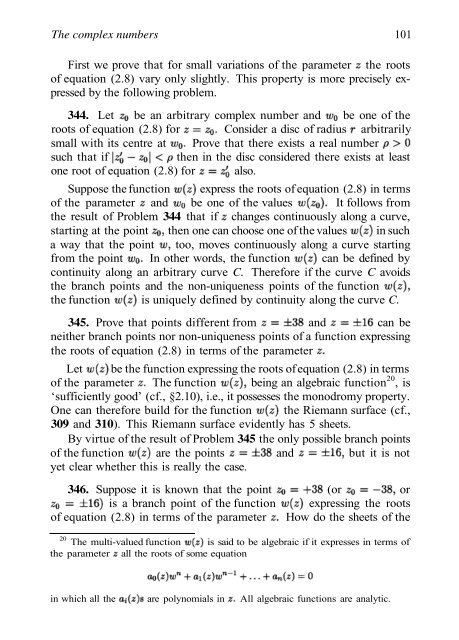Abel's theorem in problems and solutions - School of Mathematics
Abel's theorem in problems and solutions - School of Mathematics
Abel's theorem in problems and solutions - School of Mathematics
Create successful ePaper yourself
Turn your PDF publications into a flip-book with our unique Google optimized e-Paper software.
The complex numbers 101<br />
First we prove that for small variations <strong>of</strong> the parameter the roots<br />
<strong>of</strong> equation (2.8) vary only slightly. This property is more precisely expressed<br />
by the follow<strong>in</strong>g problem.<br />
344. Let be an arbitrary complex number <strong>and</strong> be one <strong>of</strong> the<br />
roots <strong>of</strong> equation (2.8) for Consider a disc <strong>of</strong> radius arbitrarily<br />
small with its centre at Prove that there exists a real number<br />
such that if then <strong>in</strong> the disc considered there exists at least<br />
one root <strong>of</strong> equation (2.8) for also.<br />
Suppose the function express the roots <strong>of</strong> equation (2.8) <strong>in</strong> terms<br />
<strong>of</strong> the parameter <strong>and</strong> be one <strong>of</strong> the values It follows from<br />
the result <strong>of</strong> Problem 344 that if changes cont<strong>in</strong>uously along a curve,<br />
start<strong>in</strong>g at the po<strong>in</strong>t then one can choose one <strong>of</strong> the values <strong>in</strong> such<br />
a way that the po<strong>in</strong>t too, moves cont<strong>in</strong>uously along a curve start<strong>in</strong>g<br />
from the po<strong>in</strong>t In other words, the function can be def<strong>in</strong>ed by<br />
cont<strong>in</strong>uity along an arbitrary curve C. Therefore if the curve C avoids<br />
the branch po<strong>in</strong>ts <strong>and</strong> the non-uniqueness po<strong>in</strong>ts <strong>of</strong> the function<br />
the function is uniquely def<strong>in</strong>ed by cont<strong>in</strong>uity along the curve C.<br />
345. Prove that po<strong>in</strong>ts different from <strong>and</strong> can be<br />
neither branch po<strong>in</strong>ts nor non-uniqueness po<strong>in</strong>ts <strong>of</strong> a function express<strong>in</strong>g<br />
the roots <strong>of</strong> equation (2.8) <strong>in</strong> terms <strong>of</strong> the parameter<br />
Let be the function express<strong>in</strong>g the roots <strong>of</strong> equation (2.8) <strong>in</strong> terms<br />
<strong>of</strong> the parameter The function be<strong>in</strong>g an algebraic function 20 , is<br />
‘sufficiently good’ (cf., §2.10), i.e., it possesses the monodromy property.<br />
One can therefore build for the function the Riemann surface (cf.,<br />
309 <strong>and</strong> 310). This Riemann surface evidently has 5 sheets.<br />
By virtue <strong>of</strong> the result <strong>of</strong> Problem 345 the only possible branch po<strong>in</strong>ts<br />
<strong>of</strong> the function are the po<strong>in</strong>ts <strong>and</strong> but it is not<br />
yet clear whether this is really the case.<br />
346. Suppose it is known that the po<strong>in</strong>t (or or<br />
is a branch po<strong>in</strong>t <strong>of</strong> the function express<strong>in</strong>g the roots<br />
<strong>of</strong> equation (2.8) <strong>in</strong> terms <strong>of</strong> the parameter How do the sheets <strong>of</strong> the<br />
20 The multi-valued function is said to be algebraic if it expresses <strong>in</strong> terms <strong>of</strong><br />
the parameter all the roots <strong>of</strong> some equation<br />
<strong>in</strong> which all the are polynomials <strong>in</strong> All algebraic functions are analytic.

















